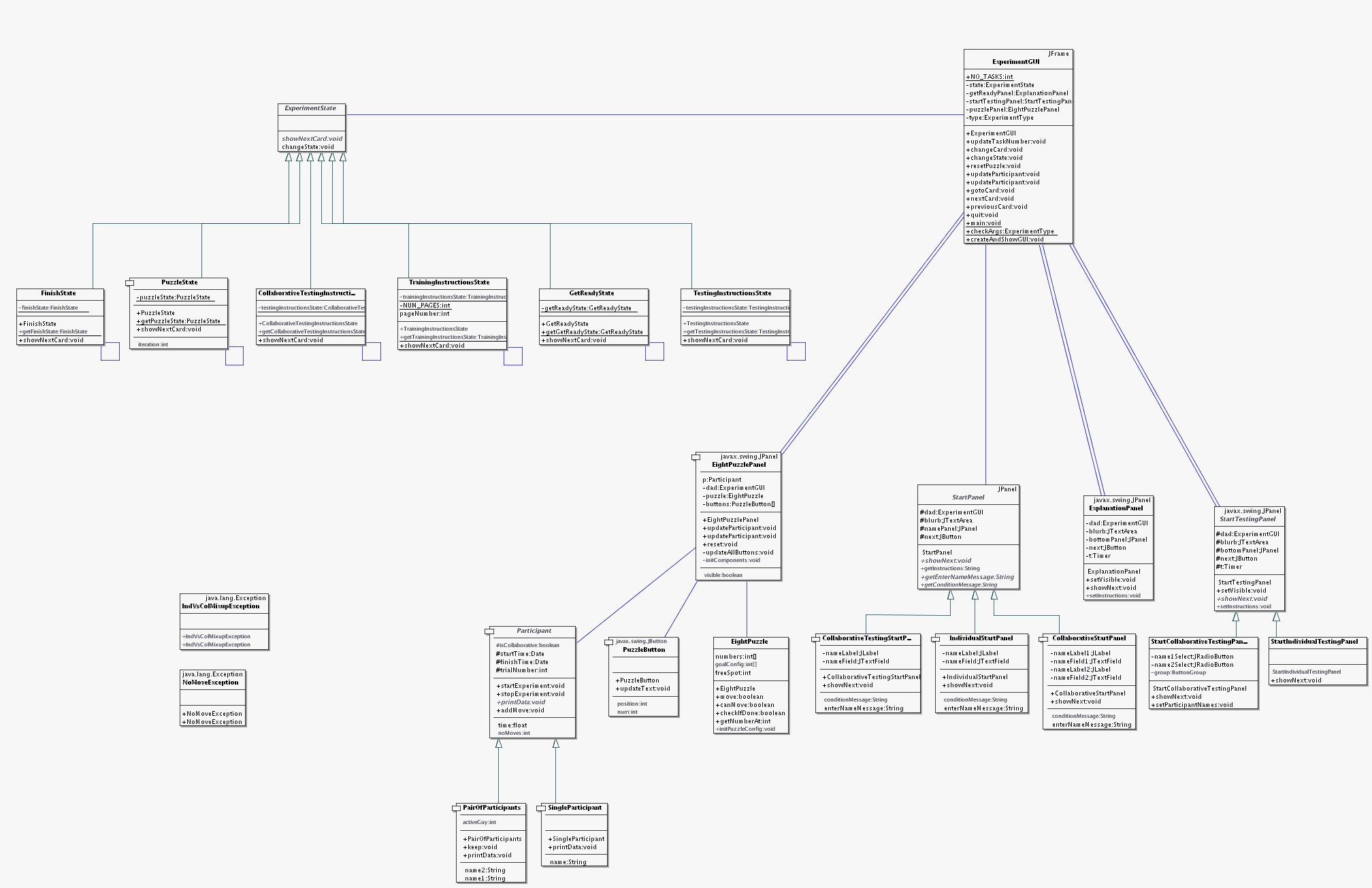Nick Brettel's eight puzzle design
Contents |
Intro
My project is on my Cosc411 experiment. This experiment was exploring whether people can solve a problem-solving task quicker when collaborating. Participants would solve #The Eight Puzzle five times, either individually or in pairs (training phase), then solve it five times alone (testing phase). The experiment was mostly automated (so they'd just read instructions, click next, etc.). Their performance was logged.
This introduced a few design challenges:
- Single partipants and pairs of participants can solve the puzzle in the training phase, so pairs and individuals need to be treated the same, but (for logging) produce different output
- The whole experiment follows a rigid process, so we need a nice way to define what we show and when.
- Moreover, participants can take one of three paths. Individual, Collaborative, or Collaborative-resume (when the pair splits up after training, one person can continue, the other jumps to the same stage).
- Individuals or Pairs need to get slightly different instructions, but they are very similar.
- The experiment is largely GUI based, but we want to separate the GUI out as much as possible.
Furthermore, I would like to be able to provide a framework from which one can easily extend the experiment if needed in the future. For example:
- can add participants who train in groups of three
- can solve a different puzzle
- can add an extra slide of instructions
All the code was written this semester (while taking Cosc427) and I tried to make a good design following the ideas we were taught. So effectively, I started with nothing. However, after the experiment was run I decided to move into a refactoring stage (specifically for this 427 project) with two goals:
- to further improve the design (duh)
- to refactor the design such that (in a hypothetical situation) it could be easily extended for future similar collaboration experiments
You can see the design as it was before refactoring at #Old Design.
Contents
- #Tour Of The Design (Go here first! A nice introduction to my design)
- #Big Picture (A view of the entire design)
- #Design Patterns (My project in regards to design patterns that were used)
- #Design Maxims (An overview of a number of design maxims, whether applied or ignored)
Code
The code is written in Java 5.0 (stupid version numbers), and you can get it here: media:427projectCode.tgz.
To run it, run `java ExperimentGui`. You can run collaborative mode with `-c` or collaborative resume with `-cr` flags.
The Eight Puzzle
The eight-puzzle is a simple game where there are 8 tiles and one blank arranged in a 3x3 grid. A tile can be moved if it is adjacent to the blank, as if it is being slid across (left, right, up or down). There is a similar fifteen-puzzle where the pieces are in a 4x4 grid.
In fact, a version of the puzzle appeared on the original Macintosh System, thanks to Andy Hertzfeld, and remained on the OS for a long time following. Anyways, I digress. You can see a screenshot of the puzzle below.
See wikipedia for more details...
Old Design
This is what my design looked like when the program was actually used to run the experiment. After this, I put on a refactoring hat for the purposes of this Cosc427 assignment. I've shown it here so I can talk about some of the changes made in design.
Firstly, let me apologise that it is so big, and that you have to scroll sideways :).
And here it is:
Tour of the Design
Here, you get a step-by-step tour through the design. This is the logical journey that digests the design in small bites. Just click the links below, in order, for a look at the main parts of the design. It'll be built up bit-by-bit, and then looking at the ../BigPicture should make more sense. Note this is not necessarily a chronological order of how it was designed, only the final design is shown, built up piecewise, in the sequence that (I think) is easiest to comprehend.

